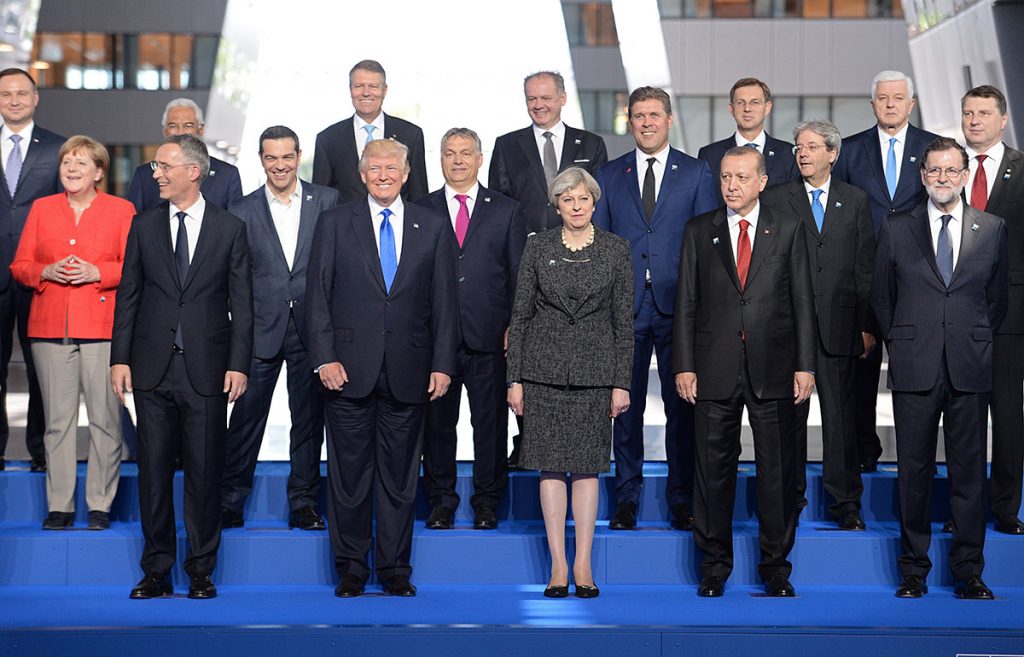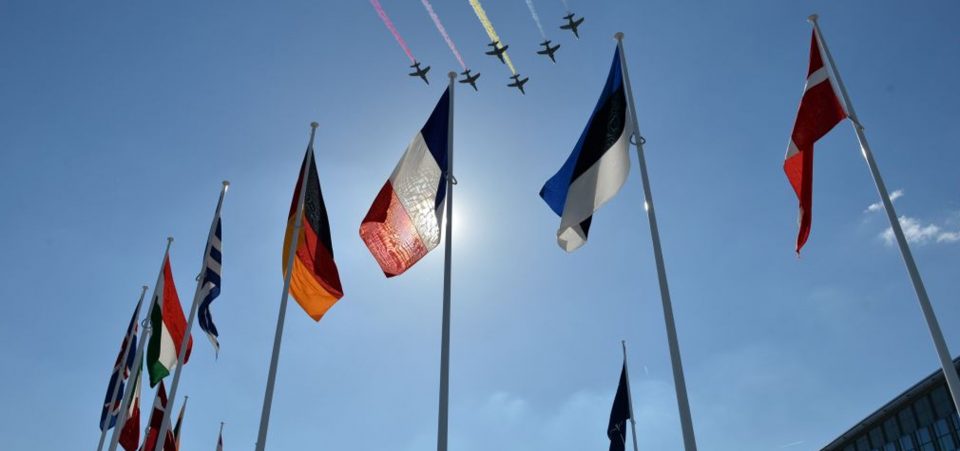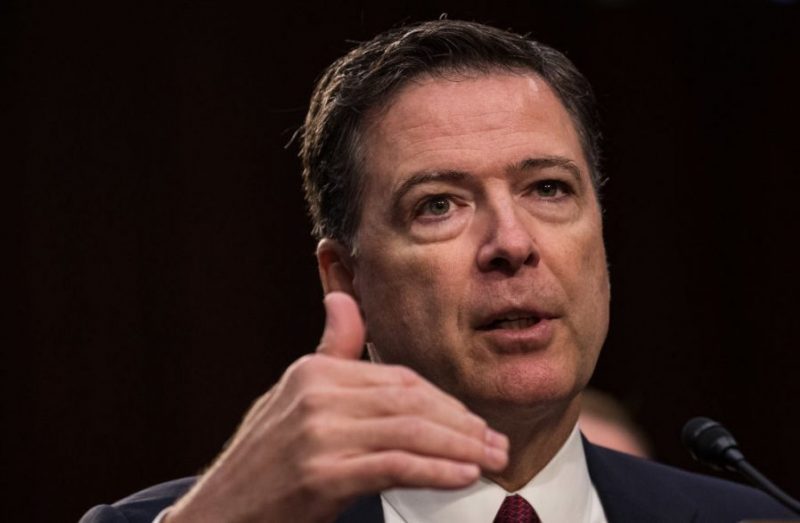Few NATO Countries Are Increasing their Defense Budgets
Are NATO countries increasing their defense budget because of pressure from Donald Trump?
The subject of “Donald Trump on defense budget” is complicated. The U.S. president has just passed one of the largest defense budgets in the history of the United States (about $700.0 billion), but, despite his appeals for other NATO members to also increase their military budgets, few have responded favorably.
Or rather, few have made the shift from nods and words to action. But some have responded enthusiastically, however, thanks to the global threats that Trump himself has revived—or at least brought back into fashion.
One of the newest NATO members has been the most enthusiastic to comply. On October 11, Lithuania announced that it would achieve the NATO objective of devoting two percent of its gross domestic product (GDP) to defense. The Baltic country’s government of 2.8 million inhabitants is worried—obsessively so—about Russia. It probably found President Donald Trump’s appeal to spend more on defense a welcome signal.
Thus, Lithuania has formally approved to increase its military budget in 2018 to 2.06% of its GDP. The percentage has been 1.8% in 2017. Thus, according to the government’s draft budget, Vilnius will spend €873.0 million next year for its armed forces. (Source: “Lithuania’s 2018 defense budget should be 2.06 pct of GDP,” The Baltic Times, October 11, 2017.)
President Trump has often accused the European members of NATO of not meeting their spending obligations on defense. The problem, according to Trump and others who share his concern, is that these European countries have relied excessively on an “American umbrella.” But, for 2018, eight NATO member countries said they would increase their military spending budgets to either meet or exceed the two-percent threshold. The United States has already, and rather enthusiastically, surpassed that threshold.
NATO Countries Defense Spending 2017
Defense spending as a percentage of GDP has dropped for all NATO countries. Even the United States (which is now increasing its military spending again) had lowered the military defense budget under the Barrack Obama administration. Candidate Donald Trump exploited this trend to his advantage during the 2016 presidential campaign. Note that between 1991 and 2015, U.S. military spending was the highest around the time of its two major wars: the Gulf War of 1990–91 and the Iraq invasion of 2003. (Source: “Military spending by NATO members,” The Economist, February 16, 2017.)
In 2016, the U.S. spent 3.3% of its GDP on defense. (Source: “Military expenditure (% of GDP),” The World Bank, last accessed October 18, 2017.)

Stefan Rousseau Pool/Getty Images
The NATO members that plan increases for 2018 include Greece, the United Kingdom, Poland, Romania, Estonia, Latvia, and Lithuania. The country, as highlighted above, has already complied. Lithuania’s defense minister, Raimundas Karoblis said his government wants to modernize the army by acquiring newer weapons, developing infrastructure, and adding more troops to the country’s various armed forces. (Source: The Baltic Times, op cit.)
Lithuania is also riding a wave of good economic fortune, which makes the higher military spending commitment easier to achieve. Lithuania is expected to achieve a budget surplus of 0.6% of GDP in 2018.
It’s hard to see how Greece might spend more on defense, considering that it’s still dealing with crippling debts that have slowed down its economy. But Greece is also a frontier country, sharing a short tract of the Mediterranean with Turkey. It’s not far from Syria, either. As ISIS has suffered increasingly crippling losses in Syria and Iraq, expectations and fears are that the thousands of foreign fighters will try to make their way back to Europe.
Greece will be one of the first European Union (EU) points of entry for such fighters. Therefore, the Greek government will have to spend more money on relevant resources. At the time of this writing, the city of Raqqa in Syria, which was considered the ISIS capital, has fallen to U.S.-backed Syrian rebels. As a result, concerns over fleeing foreign fighters are spreading.
Defense Demands Increasing: Military Spending Should Increase in All NATO Countries
But Trump may not have to nag fellow NATO country leaders to increase military budgets much longer. Apart from the threats of terrorism as ISIS fighters disperse across the Mediterranean, there is a clear reason. It has to do with North Korea and its leader Kim Jong-un’s apparent, or declared, goal of acquiring nuclear warheads even as it tests the missiles to deploy them.
Indeed, one of the main expenses in the U.S. military budget has a clear relationship to North Korea. The U.S. has increased anti-missile defense spending in the 2018 military budget because of the growing North Korean missile threat. Moreover, as Trump continues to adopt hostile language and diplomacy against Iran, the possibility of a conflict between the U.S. and Iran has also gone up.
In this sense, the “Donald Trump effect” on NATO countries is more that the U.S. president has been more belligerent toward North Korea and Iran. Still, the “defense budget in NATO countries” issue, even in rich ones like Germany, are a touchy subject. Achieving the two-percent GDP goal as Trump demands will be difficult. There are political costs. Most European voters are not impressed by suggestions of higher military spending.
Moreover, NATO defense spending as a percentage of GDP is hardly the only measure of effort or success for many NATO members. Every NATO member used to honor the two-percent GDP threshold until the year 2000. Many states are now demanding that the quality of military spending be taken into consideration, rather than just the quantity.
Defense expenditures as a percentage of GDP and annual real change (based on 2010 prices)
| Country | 2009 | 2010 | 2011 | 2012 | 2013 | 2014 | 2015 | 2016 | |
| Albania | 1.52 | 1.56 | 1.53 | 1.49 | 1.41 | 1.34 | 1.16 | 1.21 | |
| Belgium | 1.16 | 1.08 | 1.05 | 1.05 | 1.01 | 0.97 | 0.91 | 0.85 | |
| Bulgaria | 1.75 | 1.67 | 1.33 | 1.35 | 1.46 | 1.32 | 1.29 | 1.35 | |
| Croatia | 1.62 | 1.54 | 1.60 | 1.53 | 1.47 | 1.41 | 1.37 | 1.23 | |
| Czech Republic | 1.52 | 1.29 | 1.07 | 1.06 | 1.03 | 0.96 | 1.06 | 1.04 | |
| Denmark | 1.34 | 1.41 | 1.30 | 1.34 | 1.23 | 1.16 | 1.14 | 1.17 | |
| Estonia | 1.80 | 1.70 | 1.68 | 1.89 | 1.90 | 1.94 | 2.07 | 2.16 | |
| France | 2.02 | 1.96 | 1.87 | 1.87 | 1.86 | 1.84 | 1.80 | 1.78 | |
| Germany | 1.39 | 1.35 | 1.28 | 1.31 | 1.23 | 1.19 | 1.19 | 1.19 | |
| Greece | 3.08 | 2.64 | 2.38 | 2.29 | 2.22 | 2.22 | 2.38 | 2.38 | |
| Hungary | 1.14 | 1.04 | 1.05 | 1.04 | 0.95 | 0.87 | 0.94 | 1.01 | |
| Italy | 1.42 | 1.35 | 1.30 | 1.24 | 1.20 | 1.09 | 1.02 | 1.11 | |
| Latvia | 1.21 | 1.06 | 1.02 | 0.89 | 0.93 | 0.94 | 1.04 | 1.45 | |
| Lithuania | 1.07 | 0.88 | 0.79 | 0.76 | 0.76 | 0.88 | 1.14 | 1.49 | |
| Luxembourg | 0.40 | 0.47 | 0.39 | 0.38 | 0.38 | 0.39 | 0.43 | 0.44 | |
| Netherlands | 1.42 | 1.34 | 1.25 | 1.23 | 1.16 | 1.15 | 1.16 | 1.17 | |
| Norway | 1.54 | 1.52 | 1.51 | 1.47 | 1.48 | 1.51 | 1.47 | 1.54 | |
| Poland | 1.71 | 1.77 | 1.72 | 1.74 | 1.72 | 1.85 | 2.23 | 2.00 | |
| Portugal | 1.53 | 1.49 | 1.49 | 1.41 | 1.44 | 1.30 | 1.32 | 1.38 | |
| Romania | 1.33 | 1.24 | 1.28 | 1.22 | 1.28 | 1.35 | 1.45 | 1.48 | |
| Slovakia | 1.52 | 1.27 | 1.09 | 1.10 | 0.99 | 0.99 | 1.14 | 1.16 | |
| Slovenia | 1.59 | 1.61 | 1.30 | 1.18 | 1.06 | 0.98 | 0.94 | 0.94 | |
| Spain | 1.13 | 1.03 | 0.94 | 1.04 | 0.92 | 0.91 | 0.92 | 0.91 | |
| Turkey | 2.06 | 1.93 | 1.76 | 1.76 | 1.75 | 1.70 | 1.67 | 1.56 | |
| United Kingdom | 2.51 | 2.51 | 2.42 | 2.20 | 2.30 | 2.20 | 2.09 | 2.21 | |
| Canada | 1.39 | 1.16 | 1.23 | 1.10 | 0.99 | 1.02 | 0.98 | 0.99 | |
| United States | 5.29 | 4.81 | 4.77 | 4.42 | 4.09 | 3.78 | 3.59 | 3.61 |
(Data Source: NATO)
Italy and Spain have stressed their participation in many military missions, including peacekeeping ones. Germany shares this line of thinking. NATO’s secretary general Jens Stoltenberg agreed. NATO may start to assess the intensity of participation in a military mission and how much the deployment of personnel counts toward the overall commitments.
Meanwhile, of the 29 countries in the NATO countries list 2017, only five (U.S., Greece, Estonia, Poland, and the United Kingdom) currently meet the two-percent GDP target. Romania has promised to reach it by the end of the year, while Latvia and Lithuania have promised to do so by 2018. (Source: “Defence Expenditure of NATO Countries (2009-2016),” NATO, March 13, 2017.)
Founded in 1949, NATO’s original members included Belgium, Canada, Denmark, France, Iceland, Italy, Luxembourg, the Netherlands, Norway, Portugal, the United Kingdom, and the United States.
Greece and Turkey joined in 1952, Germany in 1955, and Spain in 1982. Then came three former members of the Warsaw Pact in 1999: the Czech Republic, Hungary, and Poland. Bulgaria, Estonia, Latvia, Lithuania, Romania, Slovakia, and Slovenia joined in 2004. Albania and Croatia came in 2009. Montenegro is the latest member, with its NATO membership being ratified on June 5, 2017.






